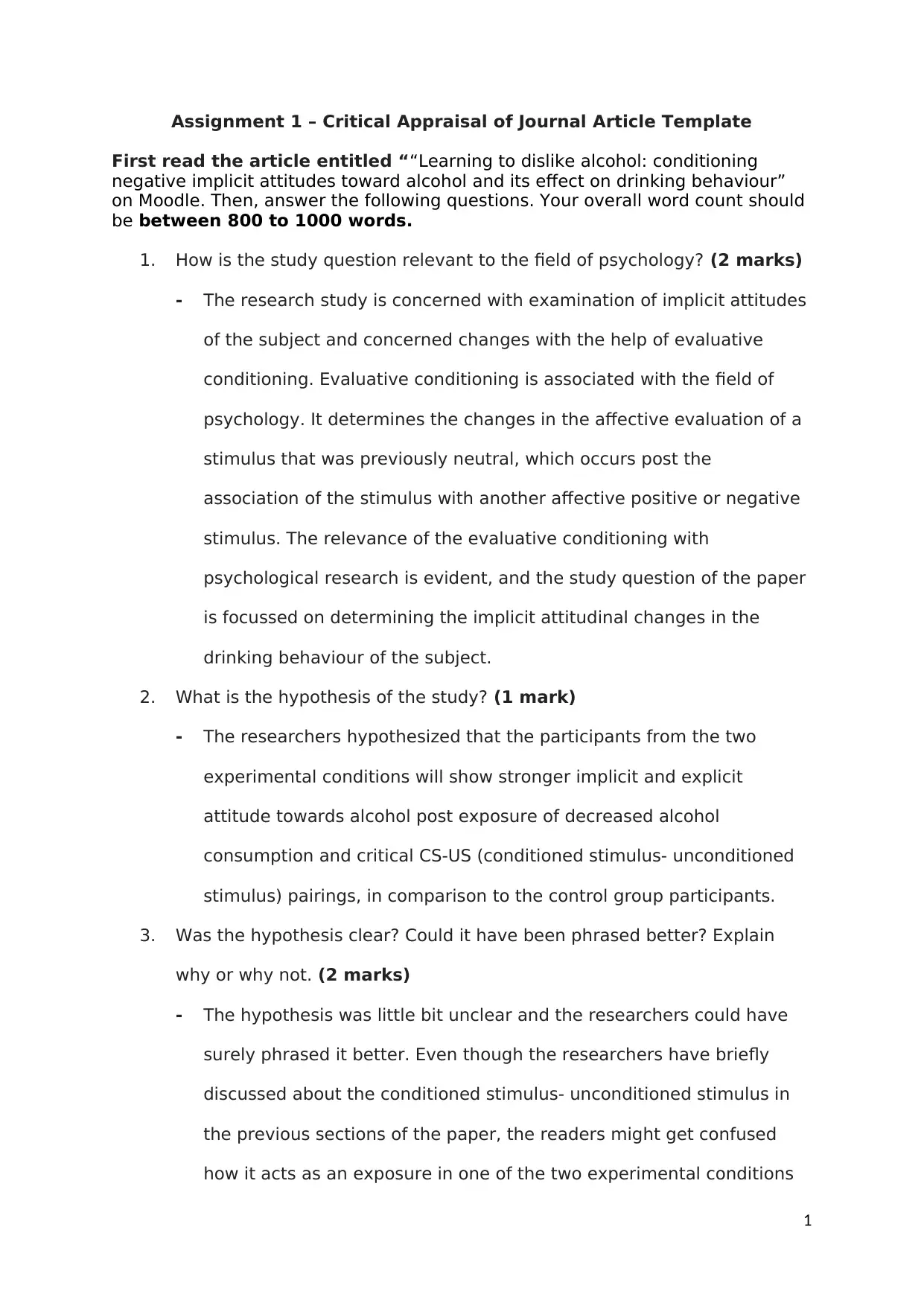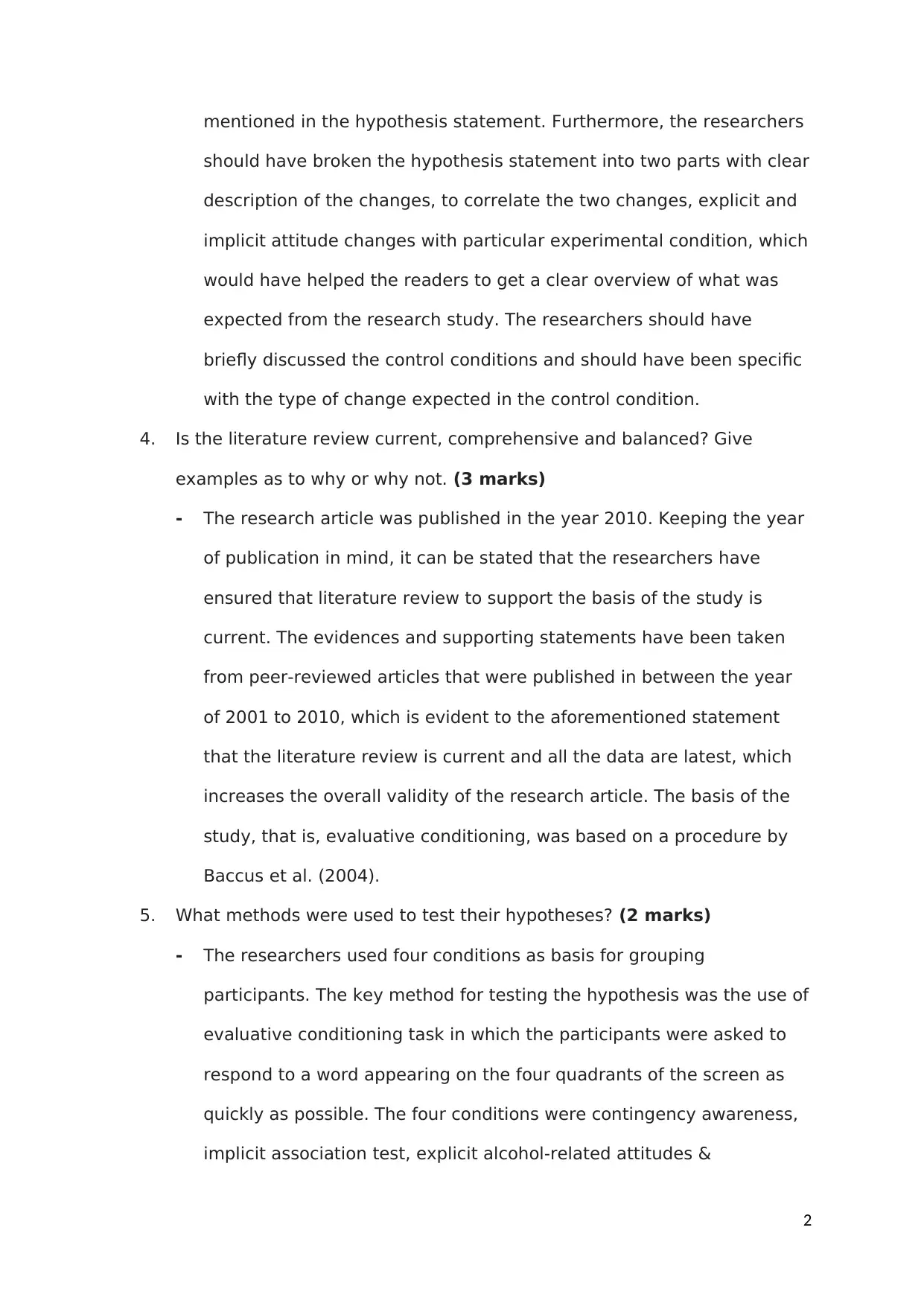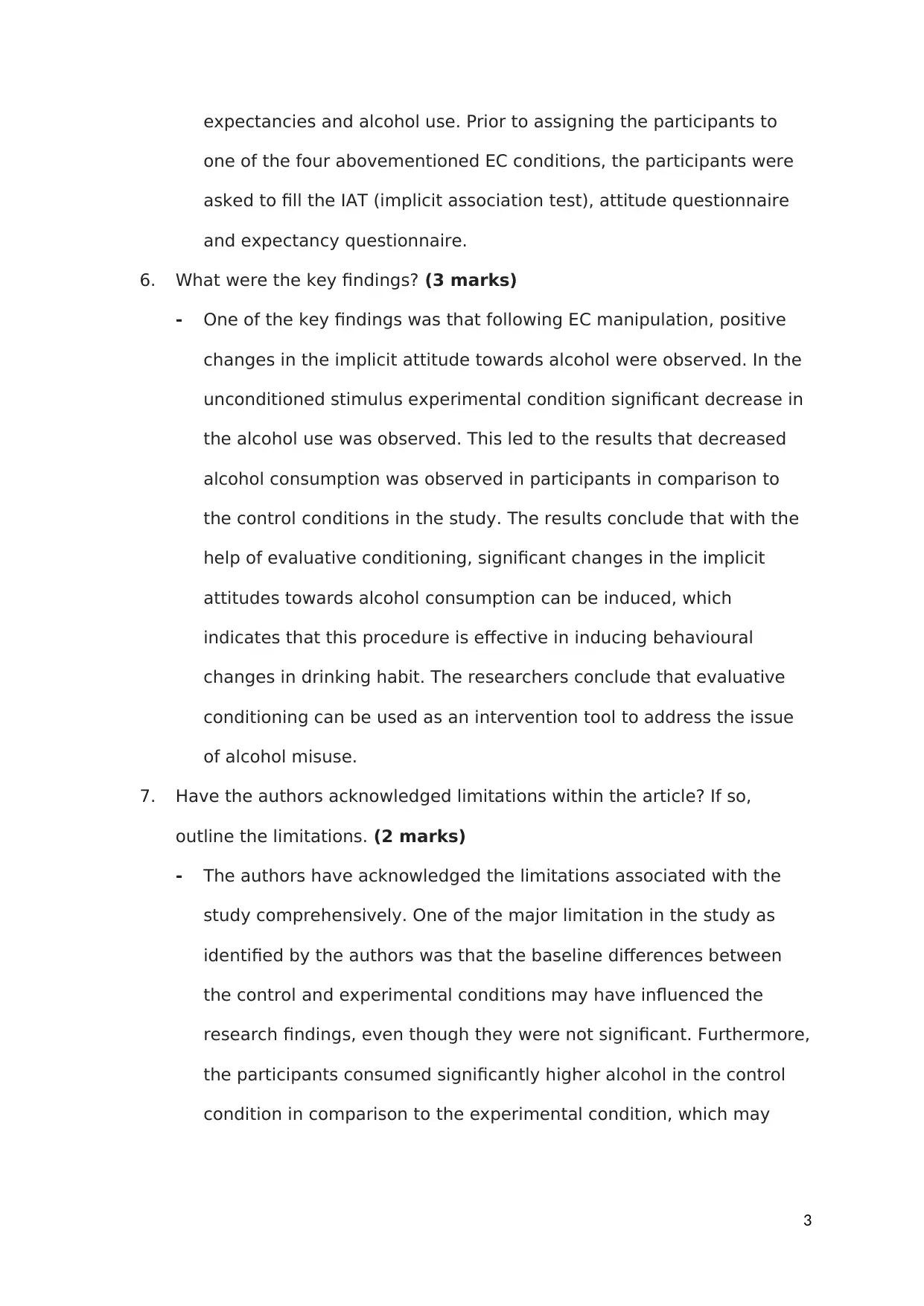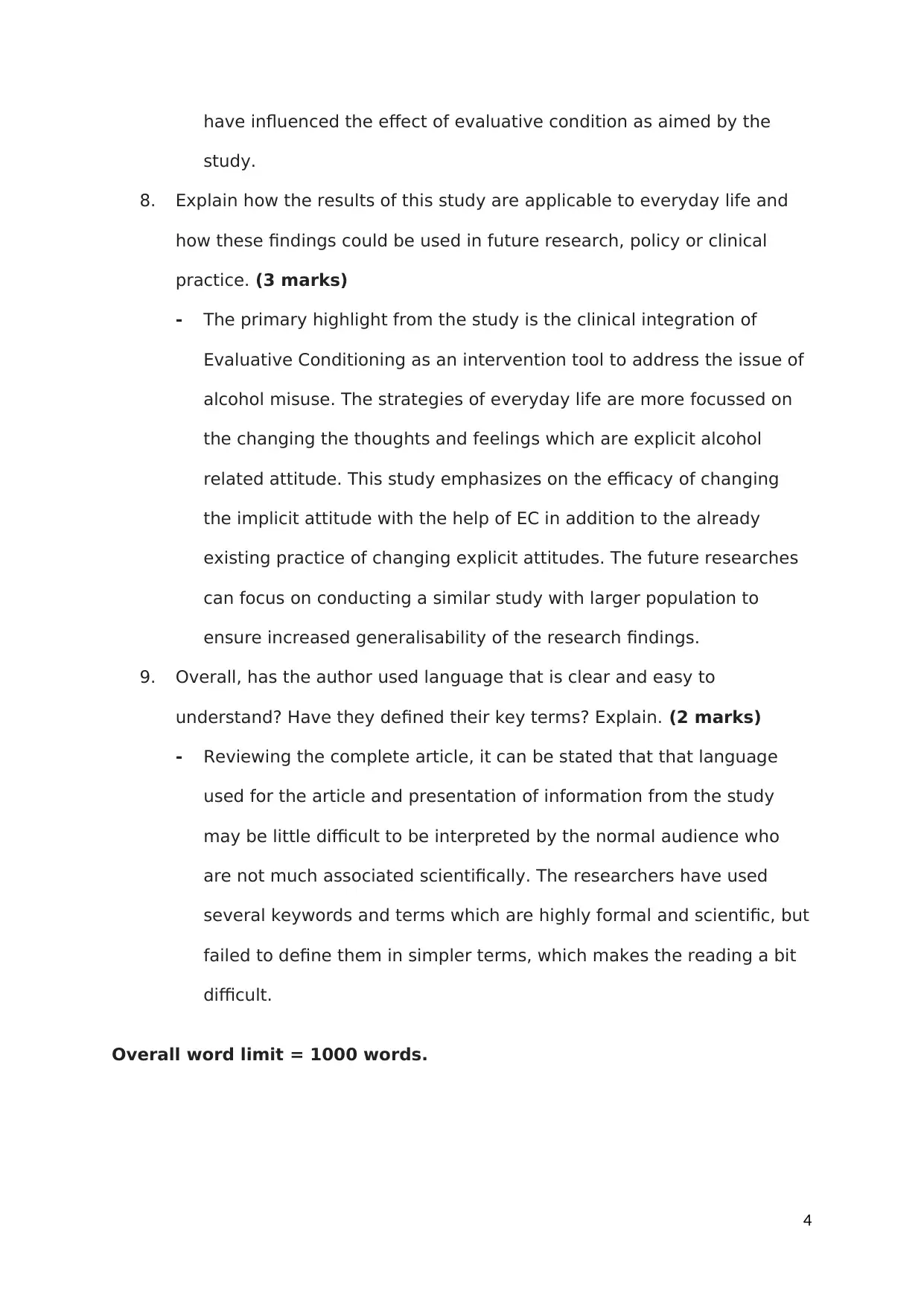Assignment 1: Critical Appraisal of a Psychology Journal Article
VerifiedAdded on 2022/07/28
|4
|1123
|299
Homework Assignment
AI Summary
This assignment presents a critical appraisal of a psychology journal article focusing on evaluative conditioning and its impact on alcohol consumption. The student analyzes the study's relevance to psychology, its hypothesis, and the clarity of its phrasing. The assignment evaluates the literature review, the methods employed, and the key findings, including the role of evaluative conditioning in influencing implicit attitudes toward alcohol. It also examines the limitations acknowledged by the authors and discusses the study's applicability to everyday life, clinical practice, and future research. The analysis covers the use of language, the definition of key terms, and provides a comprehensive overview of the research's strengths and weaknesses.

Assignment 1 – Critical Appraisal of Journal Article Template
First read the article entitled ““Learning to dislike alcohol: conditioning
negative implicit attitudes toward alcohol and its effect on drinking behaviour”
on Moodle. Then, answer the following questions. Your overall word count should
be between 800 to 1000 words.
1. How is the study question relevant to the field of psychology? (2 marks)
- The research study is concerned with examination of implicit attitudes
of the subject and concerned changes with the help of evaluative
conditioning. Evaluative conditioning is associated with the field of
psychology. It determines the changes in the affective evaluation of a
stimulus that was previously neutral, which occurs post the
association of the stimulus with another affective positive or negative
stimulus. The relevance of the evaluative conditioning with
psychological research is evident, and the study question of the paper
is focussed on determining the implicit attitudinal changes in the
drinking behaviour of the subject.
2. What is the hypothesis of the study? (1 mark)
- The researchers hypothesized that the participants from the two
experimental conditions will show stronger implicit and explicit
attitude towards alcohol post exposure of decreased alcohol
consumption and critical CS-US (conditioned stimulus- unconditioned
stimulus) pairings, in comparison to the control group participants.
3. Was the hypothesis clear? Could it have been phrased better? Explain
why or why not. (2 marks)
- The hypothesis was little bit unclear and the researchers could have
surely phrased it better. Even though the researchers have briefly
discussed about the conditioned stimulus- unconditioned stimulus in
the previous sections of the paper, the readers might get confused
how it acts as an exposure in one of the two experimental conditions
1
First read the article entitled ““Learning to dislike alcohol: conditioning
negative implicit attitudes toward alcohol and its effect on drinking behaviour”
on Moodle. Then, answer the following questions. Your overall word count should
be between 800 to 1000 words.
1. How is the study question relevant to the field of psychology? (2 marks)
- The research study is concerned with examination of implicit attitudes
of the subject and concerned changes with the help of evaluative
conditioning. Evaluative conditioning is associated with the field of
psychology. It determines the changes in the affective evaluation of a
stimulus that was previously neutral, which occurs post the
association of the stimulus with another affective positive or negative
stimulus. The relevance of the evaluative conditioning with
psychological research is evident, and the study question of the paper
is focussed on determining the implicit attitudinal changes in the
drinking behaviour of the subject.
2. What is the hypothesis of the study? (1 mark)
- The researchers hypothesized that the participants from the two
experimental conditions will show stronger implicit and explicit
attitude towards alcohol post exposure of decreased alcohol
consumption and critical CS-US (conditioned stimulus- unconditioned
stimulus) pairings, in comparison to the control group participants.
3. Was the hypothesis clear? Could it have been phrased better? Explain
why or why not. (2 marks)
- The hypothesis was little bit unclear and the researchers could have
surely phrased it better. Even though the researchers have briefly
discussed about the conditioned stimulus- unconditioned stimulus in
the previous sections of the paper, the readers might get confused
how it acts as an exposure in one of the two experimental conditions
1
Paraphrase This Document
Need a fresh take? Get an instant paraphrase of this document with our AI Paraphraser

mentioned in the hypothesis statement. Furthermore, the researchers
should have broken the hypothesis statement into two parts with clear
description of the changes, to correlate the two changes, explicit and
implicit attitude changes with particular experimental condition, which
would have helped the readers to get a clear overview of what was
expected from the research study. The researchers should have
briefly discussed the control conditions and should have been specific
with the type of change expected in the control condition.
4. Is the literature review current, comprehensive and balanced? Give
examples as to why or why not. (3 marks)
- The research article was published in the year 2010. Keeping the year
of publication in mind, it can be stated that the researchers have
ensured that literature review to support the basis of the study is
current. The evidences and supporting statements have been taken
from peer-reviewed articles that were published in between the year
of 2001 to 2010, which is evident to the aforementioned statement
that the literature review is current and all the data are latest, which
increases the overall validity of the research article. The basis of the
study, that is, evaluative conditioning, was based on a procedure by
Baccus et al. (2004).
5. What methods were used to test their hypotheses? (2 marks)
- The researchers used four conditions as basis for grouping
participants. The key method for testing the hypothesis was the use of
evaluative conditioning task in which the participants were asked to
respond to a word appearing on the four quadrants of the screen as
quickly as possible. The four conditions were contingency awareness,
implicit association test, explicit alcohol-related attitudes &
2
should have broken the hypothesis statement into two parts with clear
description of the changes, to correlate the two changes, explicit and
implicit attitude changes with particular experimental condition, which
would have helped the readers to get a clear overview of what was
expected from the research study. The researchers should have
briefly discussed the control conditions and should have been specific
with the type of change expected in the control condition.
4. Is the literature review current, comprehensive and balanced? Give
examples as to why or why not. (3 marks)
- The research article was published in the year 2010. Keeping the year
of publication in mind, it can be stated that the researchers have
ensured that literature review to support the basis of the study is
current. The evidences and supporting statements have been taken
from peer-reviewed articles that were published in between the year
of 2001 to 2010, which is evident to the aforementioned statement
that the literature review is current and all the data are latest, which
increases the overall validity of the research article. The basis of the
study, that is, evaluative conditioning, was based on a procedure by
Baccus et al. (2004).
5. What methods were used to test their hypotheses? (2 marks)
- The researchers used four conditions as basis for grouping
participants. The key method for testing the hypothesis was the use of
evaluative conditioning task in which the participants were asked to
respond to a word appearing on the four quadrants of the screen as
quickly as possible. The four conditions were contingency awareness,
implicit association test, explicit alcohol-related attitudes &
2

expectancies and alcohol use. Prior to assigning the participants to
one of the four abovementioned EC conditions, the participants were
asked to fill the IAT (implicit association test), attitude questionnaire
and expectancy questionnaire.
6. What were the key findings? (3 marks)
- One of the key findings was that following EC manipulation, positive
changes in the implicit attitude towards alcohol were observed. In the
unconditioned stimulus experimental condition significant decrease in
the alcohol use was observed. This led to the results that decreased
alcohol consumption was observed in participants in comparison to
the control conditions in the study. The results conclude that with the
help of evaluative conditioning, significant changes in the implicit
attitudes towards alcohol consumption can be induced, which
indicates that this procedure is effective in inducing behavioural
changes in drinking habit. The researchers conclude that evaluative
conditioning can be used as an intervention tool to address the issue
of alcohol misuse.
7. Have the authors acknowledged limitations within the article? If so,
outline the limitations. (2 marks)
- The authors have acknowledged the limitations associated with the
study comprehensively. One of the major limitation in the study as
identified by the authors was that the baseline differences between
the control and experimental conditions may have influenced the
research findings, even though they were not significant. Furthermore,
the participants consumed significantly higher alcohol in the control
condition in comparison to the experimental condition, which may
3
one of the four abovementioned EC conditions, the participants were
asked to fill the IAT (implicit association test), attitude questionnaire
and expectancy questionnaire.
6. What were the key findings? (3 marks)
- One of the key findings was that following EC manipulation, positive
changes in the implicit attitude towards alcohol were observed. In the
unconditioned stimulus experimental condition significant decrease in
the alcohol use was observed. This led to the results that decreased
alcohol consumption was observed in participants in comparison to
the control conditions in the study. The results conclude that with the
help of evaluative conditioning, significant changes in the implicit
attitudes towards alcohol consumption can be induced, which
indicates that this procedure is effective in inducing behavioural
changes in drinking habit. The researchers conclude that evaluative
conditioning can be used as an intervention tool to address the issue
of alcohol misuse.
7. Have the authors acknowledged limitations within the article? If so,
outline the limitations. (2 marks)
- The authors have acknowledged the limitations associated with the
study comprehensively. One of the major limitation in the study as
identified by the authors was that the baseline differences between
the control and experimental conditions may have influenced the
research findings, even though they were not significant. Furthermore,
the participants consumed significantly higher alcohol in the control
condition in comparison to the experimental condition, which may
3
⊘ This is a preview!⊘
Do you want full access?
Subscribe today to unlock all pages.

Trusted by 1+ million students worldwide

have influenced the effect of evaluative condition as aimed by the
study.
8. Explain how the results of this study are applicable to everyday life and
how these findings could be used in future research, policy or clinical
practice. (3 marks)
- The primary highlight from the study is the clinical integration of
Evaluative Conditioning as an intervention tool to address the issue of
alcohol misuse. The strategies of everyday life are more focussed on
the changing the thoughts and feelings which are explicit alcohol
related attitude. This study emphasizes on the efficacy of changing
the implicit attitude with the help of EC in addition to the already
existing practice of changing explicit attitudes. The future researches
can focus on conducting a similar study with larger population to
ensure increased generalisability of the research findings.
9. Overall, has the author used language that is clear and easy to
understand? Have they defined their key terms? Explain. (2 marks)
- Reviewing the complete article, it can be stated that that language
used for the article and presentation of information from the study
may be little difficult to be interpreted by the normal audience who
are not much associated scientifically. The researchers have used
several keywords and terms which are highly formal and scientific, but
failed to define them in simpler terms, which makes the reading a bit
difficult.
Overall word limit = 1000 words.
4
study.
8. Explain how the results of this study are applicable to everyday life and
how these findings could be used in future research, policy or clinical
practice. (3 marks)
- The primary highlight from the study is the clinical integration of
Evaluative Conditioning as an intervention tool to address the issue of
alcohol misuse. The strategies of everyday life are more focussed on
the changing the thoughts and feelings which are explicit alcohol
related attitude. This study emphasizes on the efficacy of changing
the implicit attitude with the help of EC in addition to the already
existing practice of changing explicit attitudes. The future researches
can focus on conducting a similar study with larger population to
ensure increased generalisability of the research findings.
9. Overall, has the author used language that is clear and easy to
understand? Have they defined their key terms? Explain. (2 marks)
- Reviewing the complete article, it can be stated that that language
used for the article and presentation of information from the study
may be little difficult to be interpreted by the normal audience who
are not much associated scientifically. The researchers have used
several keywords and terms which are highly formal and scientific, but
failed to define them in simpler terms, which makes the reading a bit
difficult.
Overall word limit = 1000 words.
4
1 out of 4
Related Documents
Your All-in-One AI-Powered Toolkit for Academic Success.
+13062052269
info@desklib.com
Available 24*7 on WhatsApp / Email
![[object Object]](/_next/static/media/star-bottom.7253800d.svg)
Unlock your academic potential
Copyright © 2020–2025 A2Z Services. All Rights Reserved. Developed and managed by ZUCOL.



